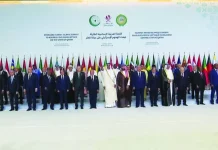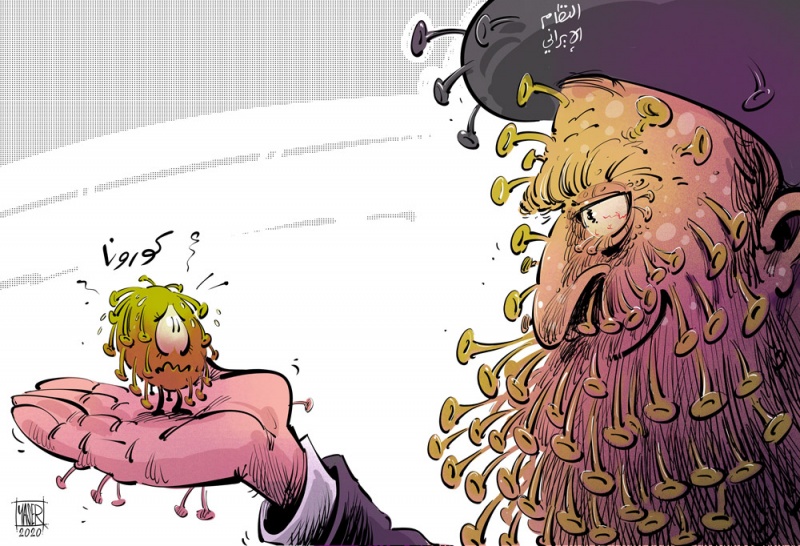Home تعليقات ومقالات مميزة هدى الحسيني/إيران تسيّس «كورونا» على أنه مؤامرة/Huda al-Husseini: Iran is Politicizing Coronavirus...
Iran is Politicizing Coronavirus as a Conspiracy!
Huda al-Husseini/Asharq Al Awsat/March 12/2020
إيران تسيّس «كورونا» على أنه «مؤامرة»!
هدى الحسيني/الشرق الأوسط/12 آذار/2020
برزت إيران كمركز رئيسي للعدوى العالمية لفيروس «كورونا» خارج الصين. والأمر الأكثر إثارة للقلق هو أن ما أبلغت عنه إيران عن حالات الإصابة بفيروس «كورونا» كان أقل بكثير من اليابان أو كوريا الجنوبية، وحتى إيطاليا، لكنّ هذه الأرقام الرسمية تتحدى الواقع، إذ إن معدل الوفيات في إيران هو أكثر من 10%، وهي نسبة أعلى بكثير من بقية العالم. المراقبون داخل إيران وخارجها مقتنعون بأن الحكومة لا تقول الحقيقة إزاء «كورونا»، وهناك خطر كبير من أن يتحول إلى وباء. تم التعرف على حالات الإصابة بالفيروس التي جرى تتبعها إلى إيران عبر مناطق واسعة من العالم، من أفغانستان إلى كندا.
لقد حدثت أكبر طفرات في الحالات خلال الأسبوع الماضي، فالناس يسقطون في الشوارع، وقد أظهرت فيديوهات على شبكات التواصل الاجتماعي هذه الحالات المخيفة، على الرغم من تأكيدات الحكومة قبل أسبوعين أن المرض قد تمت السيطرة عليه بالفعل. المقاطعات الأكثر تضرراً هي جيلان، وقم، وطهران. وقد أعلنت الحكومة عن حملة جديدة فأرسلت فريقاً قوامه 300 ألف يتنقلون من منزل إلى منزل، ويختبرون الإيرانيين بحثاً عن المرض (أو، على الأقل، عن أعراض المرض). يشير هذا إلى أن السلطات قلقة من عدم تقدم العديد من المصابين بالمرض للفحص، ربما بسبب مفهوم الخوف من الحجر الصحي القسري في المستشفيات، التي تعاني من نقص الموظفين والاكتظاظ. هنا يكمن أحد مخاطر نقص الثقة خلال أزمة صحية عمومية خطيرة. لذلك أعلن «الباسيج» أنه سيقضي على المرض!
كان رد إيران على الفيروس حتى الآن غامضاً. أرجأ النظام الإبلاغ عن حالاته الأولى، واستمر في التقليل من مدى انتشار الفيروس. لكن بعد أن أبلغ المسؤولون الإيرانيون عن عدد قليل فقط من الحالات، رد أحد أعضاء البرلمان أنه في دائرته الانتخابية وحدها، في مدينة قُم، مات 50 شخصاً بالفعل. وبدلاً من بدء العمل، رفضت وزارة الصحة الإيرانية هذه الأرقام، وكلّف علي شمخاني، أمينُ المجلس الأعلى للأمن القومي الإيراني، المدّعي العام، بالتحقيق في ادعاء النائب، وقال شمخاني: «إن نشر تقارير غير صحيحة، وإخفاء الحقيقة على حد سواء يزعزع الأمن القومي ويقوض أركان المجتمع».
أدى انتشار المرض في إيران، التي تقع في قلب أكثر المناطق غير المستقرة في العالم، إلى بروز عنصر جديد من تفجير عدم اليقين في الشرق الأوسط. كانت إيران تواجه بالفعل تحديات حادة في الداخل والخارج، من المعارضة الداخلية إلى رد الفعل الإقليمي ضد نفوذها إلى ضغوط الولايات المتحدة. لكن رد فعل النظام على أزمة الصحة العامة من المرجح أن يضعف يده على كل هذه الجبهات.
وحسب معلومات تم إرسال موظفي أمن الدولة إلى المستشفيات، لردع العاملين الصحيين عن تبادل المعلومات المتعلقة بأرقام الحالات أو النقص أو الوفيات. وتعد هذه المعلومات الآن «تهديداً للأمن القومي»، ويعاقَب عليها بالغرامات أو بالسجن.
تنتشر العدوى بشكل واضح على أعلى المستويات في الحكومة الإيرانية. في 25 فبراير (شباط)، أكد نائب وزير الصحة إراج هاريريتشي أنه مصاب، وكان شخصياً قد قلّل من عمق الأزمة مراراً وتكراراً. شوهد يسعل ويتعرَّق بغزارة خلال مؤتمر صحافي بثه التلفزيون فعُمّم الفيديو كالهشيم. ثم أعطى هاريريتشي، وهو أيضاً نائب رئيس عملية الاستجابة لفيروس «كورونا» الإيراني، مقابلة حيَّة على شاشة التلفزيون الحكومي قبل يوم من تشخيص الفيروس، ومسح أنفه بيده وسعل دون تغطية فمه – وهذا مؤشر مقلق، فبالإضافة إلى التستر على الحقيقة، تبيَّن أن الأشخاص المسؤولين في إيران ليسوا ضليعين في مكافحة الفيروسات كما يأمل المرء. انتشر الفيروس أكثر منذ ذلك الحين. وفقاً لأحد التقارير، يوجد 23 نائباً حالياً لديهم COVID – 19، أي ما يعادل 8% من أعضاء البرلمان. وقد توفي بالفعل ثلاثة من كبار المسؤولين بسبب هذا المرض، بما في ذلك المستشار المقرب من المرشد. مسؤول آخر رفيع المستوى أُصيب بفيروس هي نائبة الرئيس معصومة ابتكار، التي عُرفت بـ«الأخت ماري» عام 1979 في أثناء أزمة الرهائن الأميركيين.
الشعور بأن إيران لا تخبر الحقيقة يأتي في أعقاب احتجاجات ضخمة ضد النظام، وفي الآونة الأخيرة بعد خداع آخر للنظام. في يناير (كانون الثاني)، أسقط «الحرس الثوري» الإيراني طائرة ركاب أوكرانية فوق طهران، لكنّ الأمر استغرق عدة أيام قبل أن تعترف السلطات بمسؤوليتها عن إسقاط الطائرة.
يقول المتابعون إن إيران مسؤولة عن نشر هذا الفيروس في العراق والبحرين والكويت وأفغانستان وسلطنة عمان ولبنان والإمارات العربية وكندا والسعودية، عبر المسافرين داخل إيران، فإن عدم الثقة في التعامل مع انتشار المرض يدفع الناس للتحدث علناً وحتى للسخرية من النظام. في هذه الأثناء يتفضل الرئيس حسن روحاني، محللاً بأن الفيروس هو من «مخططات العدو» التي تهدف إلى زرع الخوف وإغلاق البلاد. وبينما أوقفت دول أخرى رحلاتها إلى الصين، واصلت إيران هذه الرحلات. وتضامناً مع ولاية الفقيه لم يوقف لبنان رحلاته إلى إيران، وهذا منتهى الاستهتار بحياة اللبنانيين.
ما يضيف إلى كارثة الاقتصاد الإيراني أن الناتج المحلي الإجمالي انخفض بنسبة 10% تقريباً في عام 2019، وتوقع صندوق النقد الدولي أن يكون النمو صفراً في عام 2020، لكن حتى هذا أصبح في خطر الآن، إلى جانب خسارتها الدخل الذي تستمده من ملايين الحجاج الذين يزورون المراقد، ولا سيما مدينة قُم، والتي حسب أرقام الحكومة الخاصة كانت مركز التفشي في إيران، مما يضاعف التأثير على الاقتصاد، لأن معظم الحجاج يُفترض أن يبقوا بعيداً، وكثيرون في لبنان لم يعودوا يرغبون حتى سماع اسم إيران. وسيجد رجال الأعمال الإيرانيون صعوبة أكبر في السفر إلى المراكز التجارية. بالإضافة إلى ذلك، سيكون من الصعب الحصول على وظائف جديدة للمهاجرين الإيرانيين، الذين يبحثون عن عمل في الخارج، مما ساعد على تخفيف الضغط على النظام بسبب ارتفاع معدلات البطالة، مع تعزيز الاقتصاد من خلال التحويلات المالية. ولا عجب أن العملة الإيرانية تنخفض.
ثم هناك نفوذ إيران الإقليمي، الذي يواجه الآن رياحاً معاكسة جديدة في العراق، حيث شجبت الاحتجاجات الضخمة ضد الفساد النفوذ الإيراني، وفي لبنان، يقال إن مقاتلي «حزب الله» العائدين من الحج إلى إيران، يرفضون الآن اتباع تعليمات الحجر الصحي، مدّعين أن كل ذلك جزء من مؤامرة ضد إيران، حسب التوجيهات التي تلقوها، والتي قد تسبب صعوبات أكثر حدّة في لبنان، وبالنسبة إلى هذه المسألة في العراق أو في أي مكان آخر في المنطقة، فقد ترى إيران تأثيرها الإقليمي ومصداقيتها يتآكلان بحدة. أيضاً من غير الواضح ما الذي سيحدث للميليشيات الإيرانية و«الحرس الثوري»، والوكلاء المرتبطين بإيران الذين يسافرون إلى النزاعات المسلحة في جميع أنحاء المنطقة، من سوريا إلى اليمن وحتى أفغانستان، ويرافقهم مقاتلو «حزب الله»؟ لقد وضع فيروس «كورونا» السلطات في واجهة ضوء أكثر سلبية.
الآن ندخل في المجهول. لا يزال الاقتصاد تحت ضغط شديد والثقة بالنظام السياسي آخذة في التراجع، وهناك أيضاً العدوى المتفشية بين المسؤولين الحكوميين رفيعي المستوى، وغنيٌّ عن القول إن انتقال السلطة في المؤسسة الدينية وسط الأزمة الحالية من شأنه أن ينطوي على خطر كبير لحاجته إلى تعبئة جماهيرية ضخمة، لكن هل الإيرانيون على استعداد لمغادرة منازلهم وتحدي إمكانية الإصابة بالفيروس؟ إنهم يفضلون مغادرة البلاد نهائياً.
Iran is Politicizing Coronavirus as a Conspiracy!
Huda al-Husseini/Asharq Al Awsat/March 12/2020
Iran has become one of the most coronavirus-infected countries in the world after China. What is most concerning is that the cases they reported were fewer than those in Japan or South Korea, and even Italy, but these numbers defy reality. That is because the rate of deaths in Iran is more than 10%, which is higher than the rest of the world.
Observers inside and outside Iran are convinced that the government is hiding the truth on the coronavirus and that there is a large chance for it to turn into a pandemic. Many cases all over the world have been linked to Iran, from Afghanistan to Canada. There were large outbreaks last week. Videos on social media showed these horrifying cases despite reassurances by the government two weeks ago that the disease was being controlled. The districts most affected are Jilan, Qom and Tehran. The government announced a new campaign and sent a 300,000-member team to go from home to home and test Iranians for the disease (or at least, for symptoms).
This indicates that the government is worried about not enough people with the virus being tested, and perhaps that is out of fear of mandatory quarantine in hospitals that are short of staff and are crowded. This is one of the dangers of a lack of trust during a public health crisis. Consequently, the Basij announced that it will get rid of the illness.
Iran’s response to the virus has been mysterious so far. The regime stalled on announcing its first cases and continued to undermine the spread of the virus. However, after officials were informed of a few cases, a lawmaker announced to his constituents, in Qom, that 50 people have indeed died. Instead of starting to work, the Ministry of Health denied those numbers and Ali Shamkhani, the secretary of the Supreme National Security Council of Iran, tasked the general prosecutor to investigate the parliamentarian’s claim.
Shamkhani said, “The reports being spread are not true, and hiding the truth jeopardizes national security.” The extent of the spread of the illness in Iran, a country at the heart of one of the most unstable regions in the world, has led to an explosive uncertainty in the Middle East. Iran faces many challenges internally and externally, from internal opposition to a regional reaction to its influence in the area and pressures by the United States.
The regime’s response to this crisis will likely weaken it on all those fronts. According to some sources, security service employees were sent to hospitals to stop healthcare workers from exchanging information on the number of cases and deaths. This information is now considered a “national security threat” and is punishable by law. The infection is clearly spreading to the higher officials in the Iranian government. On
February 25, the Deputy Minister of Health, Iraj Harichi, announced that he was infected and he had personally undermined the crisis repeatedly. He was seen coughing and sweating heavily during a press conference and the video went viral. Harichi also gave a live interview on state TV a day before he was diagnosed and wiped his nose with his hand and coughed without covering his mouth, which is worrying.
In addition to covering the truth, it seems that officials are not as aware of precautionary measures as one would hope. The virus has since spread even more. According to one report, 23 MPs have been infected with the coronavirus, which is around 8% of all parliamentarians. Until now, three high-ranking officials have died of the virus, including a close advisor to the Supreme Leader. Another official is Masoumeh Ebtekar, the Vice President of Iran for Women and Family Affairs, who was known as “Sister Mary” in 1979 during the American hostage crisis.
The feeling that Iran is not telling the truth comes after the huge demonstrations against the regime, and after another trick played by the regime when in January the Revolutionary Guards shot down a Ukrainian civilian plane above Tehran. It took a few days before the regime admitted its responsibility. Observers claim that Iran is responsible for spreading the virus in Iraq, Bahrain, Kuwait, Afghanistan, Oman, Lebanon, the UAE, Canada and Saudi Arabia through travelers from Iran. Lack of trust in how they are addressing the outbreak has pushed people to publicly and cynically speak against the regime.
During that time, President Hassan Rouhani claimed that the virus was a conspiracy to plant fear and shut down the country. While other countries stopped all travels to China, Iran continued. In solidarity with Wilayat al-Faqih, Lebanon did not stop travels to Iran, in a move that totally undermines the lives of the Lebanese. What adds to this crisis of the Iranian economy is that the GDP has dropped by 10% in 2019 and the International Monetary Fund predicted that the GDP may reach 0% in 2020. Additionally, Iran could lose revenues from millions of pilgrims, especially to Qom, which according to government estimates was the center for the spread of the virus in Iran. This will further weaken the economy because most pilgrims are required to stay away.
Many from Lebanon no longer want to even hear Iran’s name. Iranian businessmen are finding difficulty traveling to commercial centers. In addition, it will be difficult to find new jobs for Iranian migrants looking for jobs outside, which have helped reduce the pressure on the regime because of rising unemployment, after sending money from abroad. No wonder the Iranian currency is losing its value. Iranian influence in the region is also being weakened in Iraq after demonstrations against such influence broke out, and in Lebanon where Hezbollah fighters coming back from a pilgrimage to Iran are refusing to follow quarantine instructions, claiming that all of this is part of a conspiracy against Tehran.
It is not clear what is going to happen to Iranian militias and the Revolutionary Guards, and personnel affiliated with Iran who travel to conflict areas all over the region from Syria to Yemen and even Afghanistan and accompany Hezbollah fighters. The virus has put the regime in a bad situation. Now we are entering the unknown. The economy is still under severe pressures and the trust in the political regime is receding. There is also the spread of the virus among high officials, and needless to say that the shift of authority in the religious institution amid the current crisis will make popular mobilization difficult. Are Iranians ready to leave their homes and risk being infected? They prefer to leave the country altogether.




















